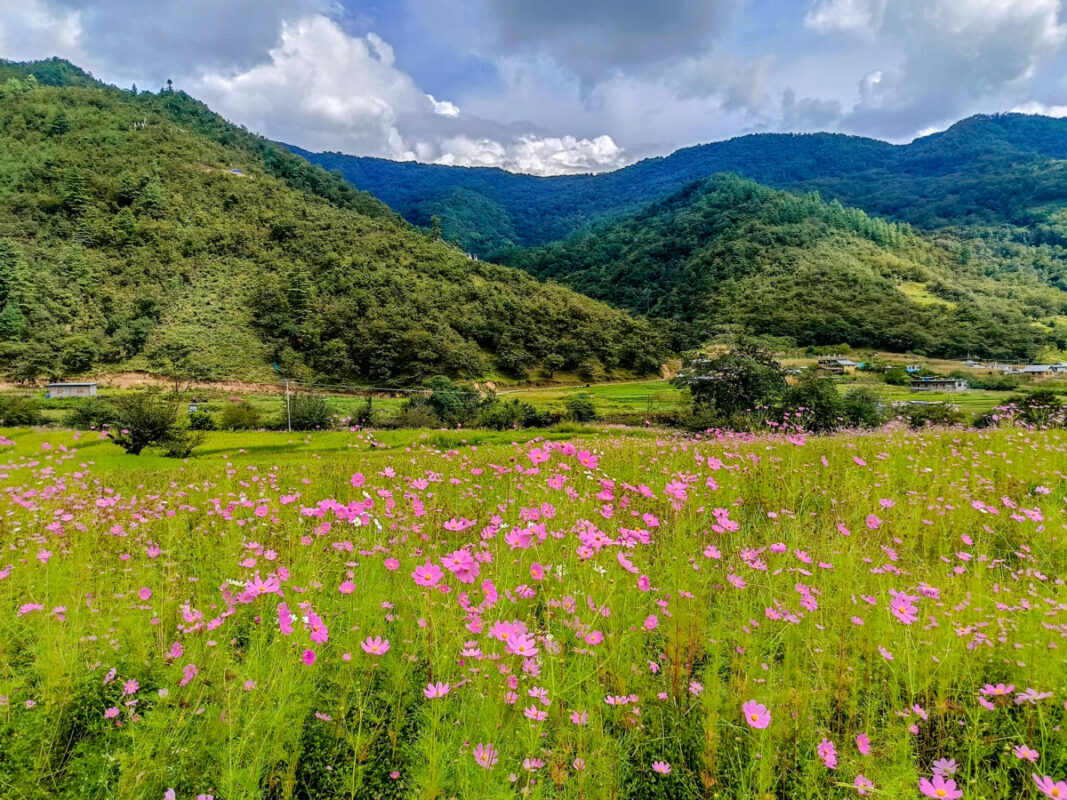Chug Valley, Dirang, Arunachal Pradesh: A Comprehensive Guide
Chug Valley, nestled in West Kameng district near Dirang, Arunachal Pradesh, is a serene Himalayan haven. Renowned for its terraced landscapes, vibrant cosmos flowers, traditional Monpa villages, and unique cultural experiences, it offers visitors a perfect mix of natural beauty and cultural richness.
Why Visit Chug Valley?
1. Unspoiled Natural Beauty
Chug Valley is a treasure trove of breathtaking landscapes, offering visitors a serene escape into the lap of nature.
- Floral Fields: From October to mid-November, the valley transforms into a vibrant wonderland with blooming cosmos flowers. These delicate blooms sway in the mountain breeze, painting the valley in hues of pink and white, making it a perfect spot for nature photography and peaceful reflection.
- Terraced Fields: The neatly arranged red rice terraces create an awe-inspiring mosaic on the valley’s slopes. Harvest season showcases their golden hues, set against the backdrop of majestic Himalayan peaks, offering a quintessential postcard-perfect view.
- Rivers and Lakes: The Chug River, also known as Khow Odok or Mangkhow, meanders gracefully through the valley, nourishing its greenery and supporting local agriculture. In the northern highlands, glacial lakes like Dawa Photsang Motsang reflect the pristine skies and surrounding peaks, creating tranquil spots ideal for meditation and exploration.
- Dramatic Peaks and Forests: Towering mountains like Jomo Usin Buthri and Phu Phrangley frame the valley, while coniferous forests blanket the lower slopes, offering a mix of rugged adventure and serene calm.
2. Rich Cultural Heritage
Chug Valley’s rich cultural tapestry is deeply rooted in Monpa traditions, providing a unique glimpse into a harmonious way of life.
- Duhumbi Heritage Fair: This vibrant annual fair celebrates Monpa traditions with cultural performances, local crafts, and authentic cuisine. Folk dances, music, and storytelling sessions bring the valley’s legends to life. The fair also serves as a marketplace for artisans to display handwoven textiles, jewelry, and pottery, making it an immersive experience for visitors.
- Living Museum: A historic Monpa ancestral home, lovingly restored by Leike Chomu, showcases traditional life. Inside, visitors find ancient utensils, bamboo baskets, and a central fireplace that once served as the heart of communal living. The attic, once used for storing grains, demonstrates the practicality and sustainability of Monpa architecture.
- Authentic Cuisine: The valley’s culinary offerings are a reflection of its culture. At places like Damu’s Heritage Dine, visitors can savor dishes like momos, thukpa, millet porridge, and fermented foods, prepared using organic, locally sourced ingredients. Culinary workshops also allow guests to learn the secrets of Monpa cooking.
3. Wildlife and Conservation
Chug Valley is not only a haven for humans but also a sanctuary for diverse wildlife, making it a must-visit for eco-conscious travelers.
- Biodiversity: Designated as a community-conserved area, the valley is home to rare species like the red panda and a variety of Himalayan birds. The forests are alive with the sounds of nature, including chirping warblers and fluttering butterflies. Rhododendrons, blue pines, and junipers dominate the landscape, adding bursts of color and texture to the scenery.
- Ecological Importance: Beyond their visual appeal, the cosmos flowers play a vital ecological role. They attract pollinators such as bees and butterflies, essential for maintaining the balance of the valley’s ecosystem. Additionally, these flowers act as natural pest repellents, protecting staple crops like red rice and millet from harmful insects.
- Wildlife Habitat: The forests and glacial regions of Chug Valley serve as critical habitats for a variety of species, including Himalayan musk deer, pheasants, and snow leopards in higher altitudes. Visitors have the rare chance to spot some of these creatures during guided treks.
4. Spiritual Serenity
Chug Valley offers a tranquil retreat for those seeking peace and introspection.
- Monasteries and Gompas: The valley is dotted with small gompas (Buddhist temples) that serve as places of worship and meditation. The serene surroundings and the gentle hum of prayers create a calming atmosphere for spiritual seekers.
- Traditional Rituals: Engage with local monks and villagers to witness or participate in traditional rituals that reflect a deep connection with nature and spirituality.
5. Unique Adventure Opportunities
For the adventurous, Chug Valley offers a range of activities to quench the thirst for exploration.
- Trekking and Hiking: Trails to peaks like Phu Tsorgan and Phu Dumba offer breathtaking views of the valley and beyond. The trek to the Dawa Photsang Motsang Lakes is particularly rewarding for its serene beauty and untouched surroundings.
- Nature Walks: Guided nature walks through the valley’s forests allow visitors to learn about local flora and fauna while enjoying the crisp mountain air.
Chug Valley seamlessly blends natural beauty, rich heritage, and ecological significance, making it a destination that appeals to travelers of all kinds. Whether you seek adventure, culture, or peace, Chug Valley has something unique to offer, ensuring it remains etched in your memory long after your visit.

